Created with Animoto.
A Few Thousand Words
Posted in Photographs
A Genealogy Blog by Dana Huff
Posted in Photographs
Created with Animoto.
Posted in Family Biographies/Histories, Genealogy and History, and Photographs
Some time back, I shared with you some photos of my great-grandfather Herman Cunningham and his WWI tentmate John Roy McCravey that my aunt Carolyn had sent me. She told me that she had an article about their reunion, but couldn’t find it at the time. Later, she took the trouble to find the article on microfilm and share it with me. Here it is:
World War I Tentmates Reunited After 50 Years
October 23, 1969, Lockney Beacon
In this age of high speed transportation, our world seems to have shrunk.
For a pair of World War I buddies, the situation was different. Herman Cunningham of Lockney and Roy McCravey of Memphis had no renewed their friendship for half a century until one day this fall.
The local man had inquired for years about his former Army “tentmate” … but to no avail.
This summer he was visiting in a Plainview convalescent home and struck up a conversation with “a fellow who turned out to be from Floydada.” During their chat, Mr. Cunningham asked the Floydada man whether he knew John McCravey.
“No,” was the answer, “but a Roy McCravey used to live there. I think he has a sister still living in Floydada.”
Cunningham’s son-in-law Connie C. Reed, a Floyd County deputy sheriff, knew the woman, who works in a Floydada restaurant. The pair went to see her.
“Do you have a brother named John McCravey?” the Lockney man inquired of the waitress.
“No, but I have a brother, Roy, who now lives in Memphis,” came the reply. Further discussion related that “John” and “Roy” were one and the same individual.
Mr. and Mrs. Cunningham were driven to Memphis for a visit with the former friend several weeks ago by a daughter. McCravey and his wife returned the visit recently.
McCravey had lived in the Plainview and Floydada areas before moving to Memphis.
He and Cunningham became friends in 1918 when they were inducted into the Army and trained together at Camp McArthur, Waco. They shared the same tent.
Later, Cunningham and McCravey shipped out together for France. Shortly after their arrival — “four or five days” — the Lockney man contracted meningitis and was hospitalized in France for treatment.
Before he was “back on his feet,” armistice had been declared.
Back in the states, Herman and Roy got together once for a visit in 1919. That was in the Cunningham home at Whitfield (now Claytonville).
“Then we both moved and we lost connection,” Mr. Cunningham says. He moved to Lockney in 1931.
For the past 50 years the World War I buddies’ trails had not crossed … until a chance conversation put Cunningham on the trail. Maybe it is a small world!
Here is a picture of Roy McCravey (left) and my great-grandfather (right) in 1918:
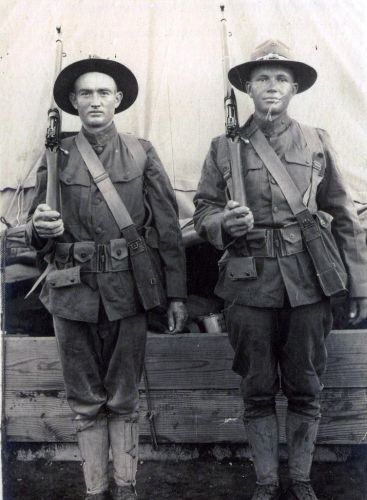
And here is a picture of the two at their 1969 reunion:
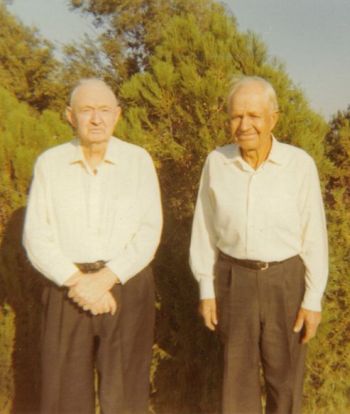
It is interesting that I was able to correctly estimate a date for this photo. I guessed it was taken in the late 1960’s or early 1970’s based on similar photos I had seen in my parents’ and grandparents’ photo albums.
Posted in Archiving, and Photographs
Civil War buffs (and genealogists who like to see Civil-War era photos) will appreciate this video:
[kml_flashembed movie="http://www.youtube.com/v/H5cqhTe-bCY" width="425" height="350" wmode="transparent" /]
Technorati Tags: video, Civil War, history, photography
Posted in Photographs, and Primary Sources: Letters, Documents, Diaries, Histories
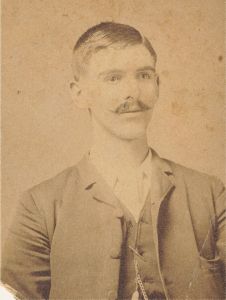 John William Tolleson is not my ancestor. If my great-great-grandmother’s life had turned out a bit differently, however, I wouldn’t be here. She was once engaged to John William Tolleson.
John William Tolleson is not my ancestor. If my great-great-grandmother’s life had turned out a bit differently, however, I wouldn’t be here. She was once engaged to John William Tolleson.
In my great-great-grandmother’s diary (PDF download), she only mentions him six times:
Even in her diary, Stella rarely vents her personal, private thoughts, but reading between the lines, it looks as if the engagement was already over or going sour by the time she began the diary. I did find it interesting that a little more than a week after she heard of his marriage, she pulled out J.W. Tolleson’s letters to her and re-read them. In a symbolic act to sever ties to the past, she and her fiancé Amos Cunningham burned some letters from J.W. Tolleson. However, I understand that some of these letters survived the purge.
I am not sure how long the engagement lasted or whether Stella and J.W. Tolleson kept in touch. On a lark, I decided to see if I could discover what happened to him. I was armed with a fair amount of information from Stella’s diary.
I searched Ancestry.com and found him on the 1910 and 1920 censuses with his wife Minnie (click thumnails for larger images).
Based on information from these census records, I was able to learn his first name was John, and that he was born in about 1865, which made him about two years older than Stella. I also learned that he moved to Oklahoma. On the 1910 census, his occupation is “Superintendent” at the “City School” in Byars, McClain County, Oklahoma. In 1920, his occupation is listed as “Teacher.” Stella Bowling also taught school before she married my great-great-grandfather Amos, and I speculated that she may have met J.W. Tolleson when they were in school together.
My grandfather’s cousin recently sent me a photo of Stella at the Parker Institute in Whitt, Parker County, Texas in 1891 or 1892 (Click for larger version):
Stella is in the middle row, far left side. She has a dress with buttons that form a “V” across her chest. I decided to see what I could learn about this school. This is what I discovered (via Handbook of Texas Online):
Parker Institute, the first school to offer college-level classes in Parker County, was established by a Mr. and Mrs. Bales in 1881 at Whitt in northwestern Parker County. In 1884 the Northwest Texas Methodist Conference selected the institute to be its flagship college in North Texas. The conference appointed Amos Bennett, a graduate of DePauw University, to be director of the school. For nine years he served as the institute’s administrator and only full-time faculty member. Assisted by instructors who had been his students in Kentucky and Texas, Bennett developed a curriculum that stressed traditional classical subjects, including Greek and Latin. Parker Institute graduated three or four students during its twelve years of existence. The first was Beulah Sprueill, who became a member of Parker’s faculty for some time. Two later had distinguished careers in the field of education. Jefferson Davis Sandefer, who graduated in 1892, served as president of Hardin-Simmons University for thirty years (1909-40), and Charles Shirley Potts, who graduated in 1893, served as dean of the Southern Methodist University law school for twenty years. Parker Institute was not able to compete with the growing number of colleges that appeared in North Texas in the early 1890s. It surrendered its charter in 1893 and became a public school.
The first graduate mentioned, Beulah Sprueill, was a friend of Stella’s. She mentions writing letters to her or receiving letters from her several times in her diary.
At Ancestry.com, I found a family tree that included John William Tolleson and Minnie Susan Mathis, so working on the hunch that the information about his middle name was correct, did a Google search for John William Tolleson. I found a post at the Tolleson Family Genealogy Forum (Genealogy.com) written by Nancy Lewis who was looking for information about the Tolleson family. I replied to her post, and we have been conversing over e-mail today.
Nancy pointed me to her Family Tree Maker Genealogy Site. While perusing her site, I discovered the following photo of John William Tolleson and wife Minnie Mathis Tolleson with their children (click for a larger version):
After studying this photo and the school photo, I think J.W. Tolleson is in the Parker Institute photo. It is hard to tell with 100% certainty, given the differences in light and the age difference in the two photos, but I believe that he could be the tall man with a mustache in the top row. It is even harder to determine whether or not Minnie Mathis is in the photo, but she resembles the woman on the far right, front row.
I was very interested to connect with relatives of Stella’s former beau, and I invite any other Tolleson researchers to connect as well. I also want to thank Nancy for sharing her family with us. To me, one of the great things about genealogy is being able to make connections like these.
Posted in Family Biographies/Histories, and Photographs
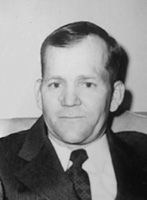 My great-grandfather, Elmer Theodore “Ted” Thurman, passed away on October 22, 2003 at the age of 93. He had been in poor health for some time, suffering from diabetes and Alzheimer’s. I have more memories of him than I do my Cunningham great-grandparents, but not quite so many memories as I have of Granny Thurman, who lived the longest during my lifetime (and in any case, was a personality to be reckoned with!).
My great-grandfather, Elmer Theodore “Ted” Thurman, passed away on October 22, 2003 at the age of 93. He had been in poor health for some time, suffering from diabetes and Alzheimer’s. I have more memories of him than I do my Cunningham great-grandparents, but not quite so many memories as I have of Granny Thurman, who lived the longest during my lifetime (and in any case, was a personality to be reckoned with!).
Elmer Theodore Thurman was born on June 5, 1910 in Roby, Fisher County, Texas, to John Edward Thurman and Mary Shelby McDaniel Thurman. His father was born in Illinois in 1871. According to my great-grandmother, he was born in Chicago, but other family researchers believe it may have been Evansville. His mother, who was known by her middle name Shelby, was born in 1873 in Sulpher Springs, Hopkins County, Texas. It is said that John Edward Thurman was an only child, and his antecedents are unclear, but it is believed his father’s name was John Edward Thurmond. His mother is believed to have died in childbirth. At the age of 16, John Thurman took a train to Indian Territory (Oklahoma), debarking at Overbrook, north of Marietta. He worked for a doctor there for some time, then made his way to Sulpher Springs, Texas, where he met and married Mary Shelby McDaniel.
Mary Shelby McDaniel was the youngest child and only daughter of Shelby McDaniel (born 1833 in South Carolina) and Mary Bates (born September 24, 1842 in Arkansas). Her father was murdered before her birth. Her brothers were named David McDaniel (born 1860), John McDaniel (born 1867), and Greenberry McDaniel (born 1870).
John Edward Thurman and Mary Shelby McDaniel Thurman were the parents of fourteen children:
All of the Thurman children listed above have passed away, but I do not have death dates for each of them yet. Artie was the last surviving sibling and passed away earlier this year.
Grandpa married Lucille Inez Willis on September 29, 1929 in Madill, Love County, Oklahoma. They had the following children: Doris LaNell Thurman Cunningham, Willis Floyd Thurman, Billy Loid Thurman, twins Winnie Sue Thurman Bolding and Minnie Lou “Penny” Thurman Paul, and Lynn Doyle Thurman. This is a picture of the Thurman family, taken between 1946 and 1948:
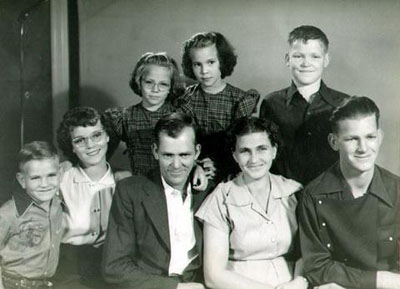
From left to right, bottom row: Lynn Doyle, Doris, Ted, Lucille, Willis; top row: Winnie, Penny, and Billy.
When I was little, Granny and Grandpa Thurman lived in Amarillo, Texas, and I remember going to visit them. When I was a teenager, they lived in Indio, California (I lived in Anaheim), and we sometimes traveled out to the desert to visit with them and Aunt Penny Paul. Toward the end of his life, he lived in Carlsbad, Texas and died in nearby San Angelo, Texas.
I remember being a bit afraid of Grandpa when I was very small. He had some form of hand tremor. I am not sure if this condition was ever diagnosed, but it appears to be genetic, as both my grandmother and Aunt Penny also have it. It is not Parkinson’s Disease, but it is possible that it is a form of Parkinsonism. He had red hair, and even in his advanced age when I knew him, it was still easy to discern his whitening hair had been red. He also had blue eyes. My grandmother, mother, sister and I (as well as my daughters) all have very large blue or green eyes, and my mother believes this round-eyed trait may come from Grandpa Thurman.
Grandpa loved to reminisce with my grandfather Udell Cunningham, his son-in-law, about people and places in the past. As his Alzheimer’s progressed, he was unable to remember more recent events, but it seemed to me that he recalled events from 50 years ago with perfect clarity.
Grandpa loved politics and was a staunch Democrat. He loved to discuss politics with my grandfather, too. My mother has told me that she has never in her life heard Grandpa say a bad word about anyone. I believe this admirable trait may be common in the Thurman family, as my cousin, Chris Stofel, says the same thing about his grandfather, Melvin Green Thurman. Certainly, I always saw my great-grandfather as very kindly and mild. It’s difficult to imagine that he ever raised his voice or became angry.
Grandpa was immensely proud of my daughter, Sarah. She was his first great-great-grandchild. She was born in 1993, and he first saw her in 1994 when the family gathered for a celebration of Granny and Grandpa’s 65th wedding anniversary. I will always remember him talking with his brother, Woodrow one day during that visit. He pointed at Sarah playing on the carpet nearby and said to Woodrow, “You see that little girl right there?” Woodrow nodded. “That little girl is my GREAT-GREAT-granddaughter.” Woodrow responded, “Well, Ted, you’re getting old.” Grandpa added, “Not too many of them get to see their great-great-granddaughter.” Before he died, he had many more great-great-grandchildren, but his Alzheimer’s had set in and he did not really remember them the way he remembered Sarah, whom he met before the disease began to take its toll. In fact, he remembered who Sarah was long after he forgot who I was, which I think is a testament to how proud he was to have a great-great-grandchild.
Granny and Grandpa Thurman were married for 74 years before he died in 2003. The last time I saw him was at a family gathering in celebration of their 70th anniversary. His health was declining. I have only had intuition that I might not see a person again three times in my life, and each time (so far), this intuition has been correct. The last time I saw my great-grandfather, I had this strong feeling that I wouldn’t see him again. It was such a strong feeling that even though we were all trying to pack into the car and leave for home, I went back into the house and hugged him a second time. I think he was confused, and he no longer remembered who I was, but I have always been glad I did that. He passed away about four years later, but I did not have a chance to visit him again beforehand.
I think my great-grandfather had a very hard life. He worked hard all of his life until he became too ill. Despite this, I never sensed from him any resentment. He’s one of the few people I’ve ever known that I’ve never heard anyone say a negative thing about. He was a very kind, very good man.
Posted in Genealogy and History, Photographs, and Primary Sources: Letters, Documents, Diaries, Histories
Slavery was a fact of life in the South before the Civil War. My family on my mother’s side is predominantly Southern, having traveled the traditional migration routes from Virginia and North Carolina to Georgia and Tennessee, Alabama, Mississippi and ending up in Texas. Some of my ancestors owned slaves.
I will never forget an incident that happened about ten years ago, when my ex-husband, who was in the Coast Guard, was stationed in North Carolina. Our Coast Guard station was small. When a family was going to be transferred, the wives all went out to lunch. When a new family came to the base, all the wives invited her to lunch. So it transpired that our leaving coincided with another family’s arrival, so our lunches were combined. I never met the woman’s husband, who was actually the one in the Coast Guard, and her name escapes me now, but I remember she said she was from Georgia. I told her I was too; I had gone to UGA. I asked her where in Georgia she was from. She told me there was no way I’d have heard of it, it was such a small town. I told her to try me. She told me from Maxeys. Well, I actually did know where Maxeys was, you see, because my ancestors in one branch of the family hail from Oglethorpe County, which is where the small town of Maxeys, Georgia is located. When I told her this, she asked my ancestors’ last name. I told her it was “Cunningham.” The look on her face spoke volumes. She was very quiet about Maxeys and Georgia and my ancestors for the rest of the meal. It was because the Cunninghams she had known in Maxeys were African-American.
I think sometimes genealogists do not like to confront negative elements in their ancestors’ pasts. It can be difficult to learn that a revered grandfather was in the Ku Klux Klan, as Joe Chapman of the Amarillo Globe News recently discovered (free registration required or use Bug Me Not). It is important to remember that people have always been a complex blend of good and evil, and I don’t think that discovering your ancestor did some things you’re not too proud of necessarily negates the good things you’ve learned about him or her.
I recently wrote about my great-great-great-grandfather, Johnson Franklin Cunningham. I’m going to tell you about another Johnson Franklin Cunningham. Here he is, pictured below with my great-great-grandfather Amos Blakey Cunningham (click to see a larger version).
This photo was taken on August 10, 1952 at a family reunion in Oglethorpe County, Georgia. My great-great-grandfather Amos returned to Georgia to visit his sister and see his former home, which he had not seen in 70 years. Johnson Cunningham was a childhood playmate. At that time, he lived in Lexington, Georgia. I decided to see what I could find out about Johnson Franklin Cunningham.
I located him on the 1880 Census with his father James and mother Charlotte in the Grove Creek area of Oglethorpe County, Georgia. The census was enumerated on June 11, 1880. I was unable to locate him (or his parents) on the 1870 census, but I do believe he had been born by the time the census was taken. In 1880, he was 11 years old and worked on his family’s farm. If you click on the thumbnail of the census image below and scroll down to line 6, you will find his family.
I was unable to locate him on the 1900, 1910, or 1920 Census, but I don’t believe that he moved. I don’t know whether this is true or not, but I suspect that racism may have played a part in whether or not Southern census-takers were diligent about counting African Americans. At any rate, I found him again in the 1930 Census with his wife Eliza in the same area — Grove Creek, Oglethorpe County, Georgia. This census was enumerated April 14 and 15, 1930. What I was able to learn about him from this census is that he was 61 years old, owned a farm, could read and write, had an adopted son named Carey B. Cunningham and two adopted daughters named Mamie Armstrong and Annie B. Cunningham, and lived on Lexington Road. He probably married about 1902 to Eliza. The entire family was born in Georgia, and both Johnson and Eliza’s parents were born in Georgia as well. If you click on the thumbnail below and scroll down to line 71, you will see Johnson Franklin Cunningham and his family.
Given that Johnson Cunningham’s age in 1880 was 11 and in 1930 was 61, I believe he was most likely born in some time between June 1868 and June 1869. Family members believed him to be 81 to Amos’s 80 years of age, but if his age on the two censuses is correct, then he would have been 83 when the photo above was taken.
I found a Georgia death record for J. F. Cunningham on Ancestry.com:
Name: J F Cunningham
Death Date: 13 Oct 1958
County of Death: Oglethorpe
Gender: M
Race: C
Age: 90 years
County of Residence: Oglethorpe
Certificate: 25882
This would indicate that Johnson F. Cunningham was born in 1868, which would seem to match the information found on the censuses. In fact, it would seem likely that if all three documents are correct, then Johnson Cunningham was probably born between June 11 and October 13, 1868.
It would most likely be difficult locate his family past the 1870 census. Probably the best bet would be to search through will books, as slaves were often named in wills. No James was mentioned in the will of Barbara Williams (see entry on Johnson Franklin Cunningham in wills). However, a Charlotte is mentioned as the child of Louiza. It is possible this is the same Charlotte. My ancestor Johnson Franklin Cunningham married Mary Ann P. Anthony, who is mentioned in Barbara Williams’ will. In fact, Barbara Williams bequeathed Louiza and her four children Charlotte, Elizabeth, Robert, and Henrietta “and the future increase” to Mary Ann P. Anthony “and her heirs forever.” It is plausible that Charlotte Cunningham, if not her husband James Cunningham, entered the Cunningham family through this will and the subsequent marriage between my great-great-grandparents. Unfortunately, the 1860 Slave Schedules of the U.S. Census did not enumerate African American slaves by name. They are listed under the names of their owners and by age and sex. Click on the thumbnail below to view the 1860 Slave Schedule listing for Johnson Franklin Cunningham of Oglethorpe County:
Assuming (and this is a big assumption) that the U.S. Census lists the correct ages for Johnson F. Cunningham’s parents James and Charlotte Cunningham, then James Cunningham would have been about 31 in 1860 and Charlotte Cunningham would have been about 19. According to the 1860 Slave Schedule above, there is no male of that age, but there is a 19-year-old female. This may be Charlotte. There are also other candidates close in age. Another piece of circumstantial evidence is that James and Charlotte Cunningham had a daughter named Louisa in the 1880 Census. It is possible that James Cunningham was not one of Johnson Franklin Cunningham’s slaves; the Cunningham family in Oglethorpe County was large even at that time. However, it does seem likely that Johnson F. Cunningham’s mother Charlotte Cunningham was owned by my great-great-great-grandfather Johnson Franklin Cunningham prior to the Civil War.
There are no Cunningham slave narratives (that I could find) at either Oglethorpe County’s Gen Web site or Ancestry.com, but it is possible there may be other documents available in Oglethorpe County libraries or another good genealogy library. I have to admire African-American genealogists who are able to trace their family histories. It’s a daunting task in the face of so many holes and incomplete or uninformative records.
I’ll close with a second picture from the family reunion. This picture features, from left to right in back, Johnson F. Cunningham, Dessie Cunningham Gray (Amos’s daughter), Amos Blakey Cunningham, Prentice Elder (Amos’s son-in-law), Velma Cunningham Elder (Amos’s daughter), Lillie Manila Cunningham Case (Amos’s daughter) with her husband Luther Clifford Case and son Virgil Case in back of her, and in front, Cadelia Elizabeth Cunningham Burkhalter (Amos’s sister) and Mary Elder (Amos’s granddaughter). This one also appears to have been taken in front of the Cunninghams’ old barn. You can click on the image to see a larger version.
Posted in Family Biographies/Histories, and Photographs
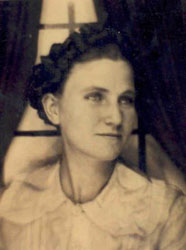 My great-grandmother, Lucille Inez Willis Thurman, passed away on February 19, 2006. Because she was my longest-lived great-grandparent, I have more memories of her than any of my other great-grandparents.
My great-grandmother, Lucille Inez Willis Thurman, passed away on February 19, 2006. Because she was my longest-lived great-grandparent, I have more memories of her than any of my other great-grandparents.
Lucille Inez Willis was born on March 19, 1914 to Grover Cleveland Willis and Melvina Meeks Willis in Marietta, Love County, Oklahoma. Her father was born in Belgreen, Franklin County Alabama in 1886, and her mother was born in Oklahoma in 1887, when it was still Indian Territory. There is a possiblity that Melvina Meeks has Native American ancestry through her Graham family, but it is not certain. I am not sure when Grover Cleveland Willis left Alabama for Oklahoma, but he was certainly there by 1905 when he married Melvina Meeks. Grover Cleveland Willis and Melvina Meeks were the parents of Myrtle Willis Vinson, Joseph Clinton Willis, Clarence O. Willis, Addie Willis Watkins, Lucille Inez Willis Thurman, and twins Willard Olen Willis and Wilma Willis McFadden. This is a picture of Grover Cleveland Willis and Melvina Meeks Willis:
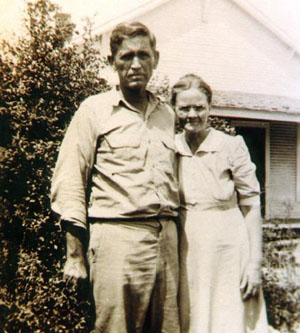
I’m not sure when the photo was taken, but I estimate it was some time in the 1940’s.
Granny married Elmer Theodore Thurman (Ted) in Madill, Marshall County, Oklahoma on September 29, 1929. They had the following children: Doris LaNell Thurman Cunningham, Willis Floyd Thurman, Billy Loid Thurman, twins Minnie Lou (Penny) Thurman Paul and Winnie Sue Thurman Bolding, and Lynn Doyle Thurman. This is a picture of the Thurman family, taken between 1946 and 1948:

From left to right, bottom row: Lynn Doyle, Doris, Ted, Lucille, Willis; top row: Winnie, Penny, and Billy.
When I was little, Granny and Grandpa Thurman lived in Amarillo, Texas. For a while when I was a teenager, they lived in Indio, California. Toward the end of their lives, they lived in Carlsbad, Texas, next door to their daughter Winnie and son-in-law Arvel Bolding. I can’t recall exactly when, but I think they lived in Ardmore, Oklahoma for a time when I was a child. I remember visiting the Ardmore area when I was a child. We visited Granny’s sister Myrtle Vinson, who has us help her shell peas. I also remember visiting the Little Brownie Bakers, who make Girl Scout Cookies. They are located in Marietta, Oklahoma. I remember Granny taking us to this bakery, raving about their great cookies. She didn’t realize they were Girl Scout Cookies. I am not sure if Little Brownie Bakers still sells directly to the public.
When Granny lived in Indio, she had a chicken that used to come into the house. I think she fed it cat food or dog food.
One of the things I will always remember about Granny is that she had more refrigerator magnets than anyone else I knew. Her refrigerator was covered with them. Most of them looked like food. I remember one in particular looked like a chocolate chip cookie; that one was my favorite. She used to let me play with the magnets when I came to visit her. She always had Dr. Pepper in bottles in her fridge, and she never failed to ask, “Do you want a Dr. Pepper, Sugie?” whenever I came to visit.
Granny also used to put out hummingbird feeders; she always had a lot of hummingbirds to watch outside her window.
When Granny lived in Carlsbad, her home was on a dirt road out in the country. Arvel Bolding had some goats that used to crop the grass, and one of them was named Lucille for Granny. There were a lot of mesquite trees and prickly pear cacti around her home.
I vividly remember going to Granny and Grandpa Thurman’s 50th anniversary party in 1979. My mother’s cousins were all there. I was eating nuts from a tray, and my mother’s cousin Billy Thurman (son of Billy Loid Thurman) told me that I couldn’t have any more because I was eating too many. I was so surprised when my grandfather’s parents, Herman and Annie Jennings Cunningham came to the party. It didn’t occur to me that my grandparents’ parents knew each other.
I was not able to go to Granny and Grandpa Thurman’s 60th anniversary party, but my mother went. I did go to their 65th anniversary in 1994. My daughter Sarah was just a baby. We had a nice family reunion with some great mesquite barbecue, and I remember Grandpa Thurman was thrilled to have his first great-great grandchild in attendance.
I also went to their 70th wedding anniversary party. There were quite a few more great-great grandchildren in 1999! Granny’s obituary stated that she had 21 grandchildren, 50 great-grandchildren, and 20 great-great grandchildren.
Granny was very funny. She liked jokes and had a great sense of humor. Mom recalls that she like wrestling and used to go to matches. She read wrestling magazines when I was little.
Granny always seemed so spry to me. She was one of the toughest people I knew, and I know she hasn’t had an easy life. Grandpa Thurman died in 2003. After Grandpa died, Granny developed leukemia. She fought it for some time, but finally, she told her family that she was tired and ready to go see Ted.
Note: This post is Part 3 in a series on grandparents and other relatives I remember personally in my lifetime.
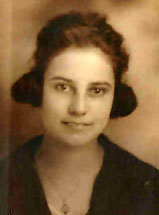 My great-grandmother, Annie Lola Jennings Cunningham, died when I was ten. As with my great-grandfather, Herman Cunningham, I don’t have many memories of her because I lived in Colorado and she lived in Texas, but, as with my great-grandfather, I do remember her.
My great-grandmother, Annie Lola Jennings Cunningham, died when I was ten. As with my great-grandfather, Herman Cunningham, I don’t have many memories of her because I lived in Colorado and she lived in Texas, but, as with my great-grandfather, I do remember her.
Annie Lola Jennings was born October 4, 1899 in Tulia, Swisher County, Texas. Her grandmother, Lucinda Fannie Curry Jennings, moved west to Texas from Alabama in the summer of 1880, after her husband, John B. Jennings, was murdered. Family legend says she feared her sons would seek revenge against the man who killed their father one day unless she moved them away. John B. Jennings and Lucinda Fannie Curry had five children: Alpha Jennings, Daisie Z. Jennings, Veto Curry Jennings (Annie’s father), Richard Otto Jennings, and Worth Alston Jennings.
One of the things I will always remember about Granny (as I called my great-grandmother) is that every time I visited her she told me that her father had the same birthday as I did — September 17. I was a child and couldn’t be less interested in some old dead man’s birthday (as I thought at the time). I could tell that Granny thought this was special, and also that she didn’t realize she had already told me (or else thought I didn’t remember). Now I feel ashamed of feeling like that, but I was just a child, so I suppose I can be forgiven. Later, when I found my great-grandmother on the 1900 census, I found in the row next to her father’s name that he was born in September 1869. I don’t think I will ever forget that moment. I realized, looking at the microfilm, that I knew exactly what day in September because Granny had told me so many times. For the first time in my genealogical research, I connected these names with living, breathing people. It was a profound moment for me.
Veto Curry Jennings married Mary A. Silla Stallings (b. March 31, 1872) on December 2, 1888 in Fannin County, Texas. They had six children: Lennice Jennings, Lee Orman Jennings, Frank Gray Jennings, Annie Lola Jennings, Daisy Eysel Jennings, and Mary Ethel Jennings. There is also a Lela May Jennings born September 13, 1892 buried in the family plot at Rose Hill Cemetery in Tulia, Swisher County, Texas. She may be a daughter who died at birth or shortly thereafter.
Granny’s grandmother, Lucinda Fannie Curry Jennings was living with her son Veto Curry Jennings at the time of her death on September 18, 1912. Granny and her sisters found their grandmother. Mary A. Silla Stallings Jennings, Granny’s mother, had died two years before on June 18, 1910. Veto Curry Jennings remarried Venera L. Cluck . She was known in the family as “Aunt Jenny”; it was she who suggested the name Udell for my grandfather after a book she liked, Harold Bell Wright’s That Printer of Udell’s.
Annie Jennings became a teacher and met her future husband, Herman Cunningham, when she boarded at the Cunningham house. It was in this same way that Herman Cunningham’s parents, Amos Blakey Cunningham and Stella Ophelia Bowling met; she was a teacher and boarded with a number of county families, including the Cunninghams, in the 1890’s.
Annie Jennings and Herman Cunningham married on June 20, 1920 in Tulia, Swisher County, Texas. These photographs were taken on their wedding day:
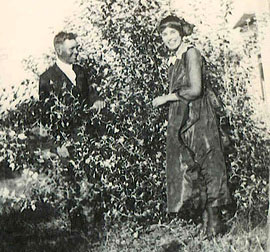
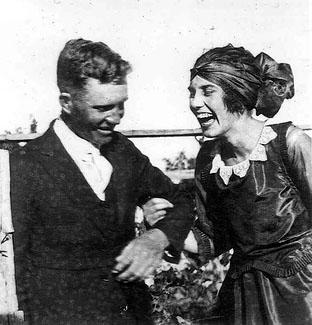
My mother’s cousin Connie Luene Reed Bertrand, is currently in possession of Granny’s wedding dress. According to Connie Lue,
It is navy with handmade pleats and lace and all. It is in pretty bad shape, but I can’t throw it away.
It seems that after Papaw [note: I have only ever seen Herman’s nickname spelled Pa Pa, and this is how I remember it being spelled on the funeral wreath at his wake/viewing] died, Granny may have taken his death worse than any of us knew. Carolyn [Carolyn Cunningham, Annie’s daughter] came home from work one day and found this wedding dress in the trash barrel. Luckily, Granny had not burned the trash (you may not know that in the olden days, folks around here burned their own trash and garbage in large metal barrels). Carolyn didn’t ask her about it. She just took the dress out of the trash and hid it from Granny until she came to work, here in Floydada, the next day. Carolyn called me and I came to get it and still have it.
We thought that maybe she was angry with Papaw for dying. I’ve heard of that and it would make sense that she did do that. As far as I know, she never mentioned throwing the dress away to anyone and never knew that Carolyn had saved it.
If you ever are in the neighborhood, you MUST come by and see this dress. Mom showed me some of the features of the dress and explained why it was made the way it was. One of the features is a maternity feature. She made it for an “all occasion” dress since they were poor. It is very ingenious. And it is very beautiful.
I know that my great-grandmother and her daughter Flois were both seamstresses. My grandmother told me about showing Granny some dresses she had made for my mother in order to earn her approval. Granny was somewhat notorious in her dislike for her daughters and sons-in-law; she had been known to refer to them as her “out-laws.” My mother, however, says that she was very loving and gentle with her grandchildren, and that is how I remember her, too.
Mom says that when she was little and scraped her knee, she preferred to go to Granny to get fixed up rather than her own mother. She insisted that although Granny and my grandmother did the same thing — put Campho-Phenique and a bandage on the scrape — Granny blew on it, which Mom insists prevented it from hurting.
Granny always sent me a card for my birthday. I remember one year that she sent me some toy cars as a gift; I can no longer remember if it was a birthday or Christmas gift, but I think it was Christmas. I wrote a thank-you note and showed it to my mother. Mom was aghast because she felt that my letter was rude. I remember what I said, and Mom was right. I told Granny “Thank you for the cars, but we are not boys.” Mom made me rewrite it, so thank goodness I never sent that rude letter to my Granny! My edited letter was much more gracious.
I will always remember Granny in her kitchen. Even in her 80’s, her hair was jet black. My grandfather heard the family had Cherokee ancestry. He believed himself, according to family legend, to be 1/8 Cherokee through his mother’s family. If this were true, Granny would have been 1/4 Cherokee, meaning one of her grandparents — John B. Jennings, Lucinda Fannie Curry, John Thomas Stallings, or Sarah Long Thomas would have been full-blooded Cherokee. I can find absolutely no corroboration for this. I don’t entirely discount that there may be Cherokee ancestry, as my grandmother had dark skin, eyes, and hair, as well as high cheekbones, that are common features of Native Americans, but I can find no proof that Annie had a Native American grandparent, and such stories should be taken with the proverbial grain of salt.
Granny used to make orange Kool-Aid for Pa Pa (my great-grandfather). My mother asked Granny if she might make another flavor some time, but Granny insisted that was what Pa Pa liked.
Granny also used to tat lace. She tatted snowflake Christmas ornaments that several family members have. She also used to crochet. She made booties for me when I was a baby. I still have one bootie (it’s mate, sadly, has been lost in various moves we have made). It is in good condition except the ties used to have balls on the ends that have fallen off. My own daughters wore these booties, but the mate had been lost by the time my son was born.
I only remember visiting Granny a few times before she died on April 8, 1982. She had a stroke. My aunt Carolyn found her when she came home. She entered the hospital and had a second stroke some days later, which was the cause of her death. Many family members believe that she simply didn’t want to live without Pa Pa. He died eight days before their 60th wedding anniversary.
I remember going to her funeral, but not as clearly as Pa Pa’s. For instance, I do not remember going to a viewing, though we probably had one, and I do not remember the service at all, as I remember Pa Pa’s. My recollections are very vague.
As with my great-grandfather, I wish I had been able to know her better, but I suppose I am fortunate to have known her at all.
Sources:
Bertrand, Connie Lue. “Cunningham Picture.” E-mail to Dana Huff. 5 Aug. 2005.
Jennings, Jan. 2006. Descendants of John B. Jennings. (PDF version of document sent in e-mail to Dana Huff, 24 Jul. 2006).
Note: This post is Part 2 in a series on grandparents and other relatives I remember personally in my lifetime.
Posted in Family Biographies/Histories, and Photographs
 On February 19, our family lost its matriarch — my great-grandmother, Lucille Thurman. Granny, as she was affectionately known by all of her grandchildren, was 91 years old. Granny had been ill with leukemia for some time preceding her death. She was buried in Marietta, Oklahoma, next to my great-grandfather, Elmer Theodore “Ted” Thurman, who passed away two years ago this past October.
On February 19, our family lost its matriarch — my great-grandmother, Lucille Thurman. Granny, as she was affectionately known by all of her grandchildren, was 91 years old. Granny had been ill with leukemia for some time preceding her death. She was buried in Marietta, Oklahoma, next to my great-grandfather, Elmer Theodore “Ted” Thurman, who passed away two years ago this past October.
Granny was born Lucille Inez Willis, the fifth of seven children, to Grover Cleveland Willis and Melvina Meeks Willis on March 19, 1914 in Marietta, Love County, Oklahoma. She married my great-grandfather when she was fifteen and gave birth to six children: my grandmother Doris LaNell Thurman Cunningham, Willis Floyd Thurman, Billy Loid Thurman, twins Winnie Sue Thurman Bolding and Minnie [Penny] Lou Thurman Paul, and Lynn Doyle Thurman. She was preceded in death by her son Billy, husband Ted, and daughter Winnie.
At the time of her death, Granny had approximately 20 grandchildren, about 50 great-grandchildren, and about 20 great-great-grandchildren.
I will always remember Granny as feisty. There was nothing she wasn’t bold enough to say. She called all of us kids “Sugie.” She used to keep Dr. Pepper in bottles in her fridge, which was covered by more refrigerator magnets than I’ve ever seen on anyone else’s fridge. She used to let us play with them when we visited her. She had a keen sense of humor, and she enjoyed a good joke.
On February 16, she told family members she was “tired” and “ready to go see Ted.” She died in her sleep about 9:00 in the morning on February 19.
My distant relation Helen Lowry sent me the following photo yesterday:

Front row, left to right: Johnson Franklin Cunningham, Mary Anne Penelope Anthony Cunningham, possibly Charles Benjamin Cunningham or Alexander Stephen Cunningham.
Back row, left to right: Possibly Johnson Hood Cunningham or Charles Benjamin Cunningham, Mary Elizabeth Cunningham (Mollie — later married name Bragg), Martha Lugena Cunningham (Mattie — later married name also Bragg), and Amos Blakey Cunningham.
I estimate that the photo was taken between 1882 and 1884 based on the appearances of the children. I am not positive about the identities of the tallest boy in the back row or the boy in the front row. Family records have indicated that the youngest Cunningham son, Alexander Stephen Cunningham, died as an infant. The oldest boy on the far left seems to look older than my great-great-grandfather Amos, based on height; however, it should be noted that Amos was noted for his short stature — the family called him Little Grandpa, and his wife Stella mentions in her diary that he weighed 115 pounds as a full-grown man in his twenties. If the tallest boy is indeed Charles, then the young boy must be Alexander, and it would seem that he did not die as an infant as all our genealogical records indicated.